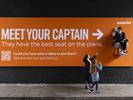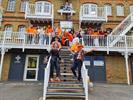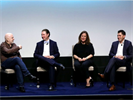Paul Holmes 06 May 2001 // 11:00PM GMT
Stroke is the third leading cause of death and a leading cause of long-term disability in the United States. In spite of this, it is staggering that more than 75 percent of the population cannot name a single stroke warning sign. Additionally, many people are unaware of aspirin’s benefits for stroke prevention. It was these statistics that became the rallying cry for the American Stroke Association (ASA) and Bayer Aspirin. Led by Golin/Harris International, the group created the American Stroke Challenge (ASC) to increase awareness of stroke, its warning signs and treatment options. The campaign consisted of a competition between two professional golfers (a “battle of the sexes”), a million dollar contest, a satellite media tour, PSAs, local promotions and national/local media relations. Media coverage increased stroke awareness and solidified the ASA’s position as a leader in stroke education. The ASC helped Bayer Aspirin increase sales by nine percent during the program’s month-long execution. Additionally, media results exceeded established client expectations by 21 percent.
RESEARCH
Why golf? Market research was conducted to determine the top leisure activities for our target audience, those aged 35 and over, who were susceptible to stroke and prime users of cardiovascular drugs. It was determined that golf was a top leisure activity for people in this category.
CHALLENGE/OPPORTUNITY
As a successful six-year-old program, the ASC has become a test for the most creative folks to build on the existing program to give it a fresh and broader appeal. By all accounts, the previous year’s media results, more than 196 million impressions, were above and beyond everyone’s wildest expectations. How would we continue to make this story exciting and innovative for media and consumers?
Over the years, the ASC worked with hundreds of golf courses, many professional golfers and dozens of local ASA affiliates. The big question for the team was how could we get them excited about another year of the program? How could we maximize their involvement? And most importantly, how could we make the ASC a stronger franchise program for Bayer?
OBJECTIVES
Increase awareness of stroke and its warning signs
Raise more than $200,000 for the ASA for stroke education and research
Position the ASA as the leader in stroke education and research and Bayer Aspirin as a forerunner in preventive treatment to fight stroke
Increase participation of local AHA/ASA affiliates in local campaign promotions
Expand program reach and target audiences by including top Bayer Aspirin retailers
Increase Bayer Aspirin sales during May
STRATEGIC APPROACH
Golin/Harris focused on creating a program that incorporated spokespeople with a personal connection to stroke and an umbrella theme to unify all the elements. Also critical to the program’s success was strong buy-in by ASA affiliates encouraging them to develop local events utilizing promotional materials. To extend media coverage, we crafted our story to appeal beyond sports media to include specifically targeted healthcare/general assignment reporters by providing local physicians and stroke victims to provide interviews. The missing piece to our program was an element to raise the eyebrows of consumers who often shopped at Bayer Aspirin retailers. This would allow everyone to see whether the program had a life beyond traditional educational outreach efforts.
EXECUTION
The American Stroke Challenge lasted the entire month of May, Stroke Awareness Month, with a $1 million hole-in-one contest as the grand finale. The event was held in Los Angeles because of the number of celebrities in the area and hosted by Corey Pavin and Jerry Orbach from NBC’s “Law & Order” to appeal to create sports and entertainment media placements.
Notable professional golfers – PGA TOUR player Corey Pavin and LPGA sensation Meg Mallon – were slated to be the lead spokespeople for the program. Both have strong familial connections to stroke – Pavin’s grandmother died from a stroke and Mallon’s mother has suffered a succession of mini-strokes. The golfers’ efforts were not only focused on raising awareness of stroke but also raising funds for stroke education and research. For every birdie the two recorded during golf tournaments in May, Bayer Aspirin would donate $1,500 to the ASA. This “Battle of the Sexes” birdie competition allowed us to focus stories locally on stroke education efforts in tournament locations. When the final ball dropped into the cup, Mallon finished strong beating Pavin 39 to 21.
To broaden the appeal beyond sports, besides Orbach, Broadway talent Ben Vereen was signed on to assist in media efforts. Both celebrities also have a strong connection to stroke with Orbach’s father dying from a stroke and Vereen personally suffering a stroke a few years ago, only to come back from it and win a Tony Award. Celebrities were utilized to expand audience reach and program recognition.
We maximized the staff and volunteer resources of the ASA, expanding the program to include 10 ASA affiliates in Atlanta, Boston, Chicago, Dallas, Los Angeles, Miami, New York, Phoenix, Seattle and Tampa. In each of these cities, 10 public golf courses, for a grand total of 100 golf courses, were signed on to act as the main hubs of information distribution and the location points where thousands of people could enter for a chance to participate in the $1 million hole-in-one contest and be screened for stroke risk.
Bayer Aspirin retail involvement consisted of enlisting the participation of two top retailers – CVS and Rite-Aid. Each retailer participated in the sweepstakes by dispensing stroke information through hundreds of stores and giving customers the opportunity to enter for the chance at the $1 million hole-in-one contest.
Media efforts included:
Scheduling the program kick-off event at a location where millions of dollars are raised and lost on a daily basis – New York City’s Wall Street – with Pavin and Mallon challenging each other to a putting contest and raising $130,000 for the ASA
Kicking off the program with a “CBS Early Show” segment where Bryant Gumble putted to raise some money
Conducting a satellite media tour with Ben Vereen to capture key placements in local markets
Providing ASA affiliates with PSAs featuring Vereen, Pavin and Mallon highlighting the program and stroke education information
Coordinating month-long media relations efforts nationally and locally in each participating market by both Golin/Harris and local ASA affiliates
Targeting media outreach for every $1 million hole-in-one contest participant with b-roll footage of their $1 million hole-in-one attempt to each of their hometowns
Promoting a special bonus event honoring the city with the most sweepstakes entries (Boston) – Mallon hosted a round of golf and putting clinic fresh off her second-place finish in the U.S. Open
RESULTS
In 2000, the program raised $250,000 for the ASA, well over the goal of $200,000. The grand total over six years is $960,000. It also increased Bayer Aspirin sales by nine percent during the month of May over the same month’s result the previous year.
The outstanding results and feedback from local affiliates helped strengthen the relationship between ASA and Bayer Aspirin, one of its largest corporate partners. The ASC was the only national stroke fundraiser for ASA in 2000.
The month-long campaign generated more than 242 million impressions (a 21-percent increase over established goals) through six Associated Press stories, two USA Today articles and dozens of local media placements. Local ASA affiliates provided localized stories to media and conducted stroke assessments using ASA medical staff on site at local golf courses. Ninety-two percent of stories were Bayer Aspirin-branded, 90 percent ASA-branded and 65 percent contained key stroke messages.
The participation of 10 ASA affiliates and markets in 2000 marked an increase of 40 percent over 1999. The success of the ASC retail expansion to include CVS and Rite-Aid has led to increased interest from Bayer Aspirin retailers to the extent that the 2001 program will include nine retailers for an increase of 400 percent.


































.jpg)

















